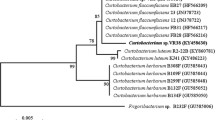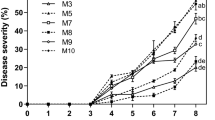Abstract
Benthiavalicarb is a new fungicide active against Oomycetes fungal plant pathogens. The present study shows that benthiavalicarb is effective for controlling the Oomycete fungal pathogen Plasmopara viticola, which causes downy mildew in grapevines. The fungicide did not affect zoospore discharge from sporangia of P. viticola, but strongly inhibited zoospore encystment, cystospore germination in vitro and mycelial growth, together with sporangial production in vivo. Benthiavalicarb showed strong prophylactic and local activity in intact plants or detached leaves and low translaminar activity. The compound was not translocated from leaf to leaf in either a acropetal or basipetal direction. Benthiavalicarb applied at 1, 3 and 6 days post-inoculation protected grapevine plants against downy mildew and inhibited sporulation of the pathogen. Similar results were obtained on leaf disks if benthiavalicarb was applied up to 96 h post-inoculation. Benthiavalicarb diminished the sporulation of P. viticola when applied to established disease in the tissue. Benthiavalicarb remained active on leaves for a period up to 28 days. Two foliar applications of benthiavalicarb, 2 weeks apart, to field-grown grapevines inhibited downy mildew development and were as effective as the standard metalaxyl-Cu treatment in controlling the disease. A formulated mixture of benthiavalicarb + Folpet was similar or superior in performance to metalaxyl-Cu and the new strobilurin trifloxystrobin in controlling downy mildew. The effectiveness of benthiavalicarb makes it well suited for integration into a control programme against downy mildew disease in vineyards, and as a component to delay resistance buildup.
Similar content being viewed by others
References
Baldwin BC, Clough JM, Godfrey CRA, Godwin JR and Wiggins TE (1996) The discovery and mode of action of ICI A5504. In: Lyr H, Russell PE and Sisler HD (eds) Modern Fungicides and Antifungal Compounds (pp 69-77) Intercept, Andover, UK
Bartlett DW, Clough JM, Godwin JR, Hall AA, Hamer M and Parr-Dobrzanski B (2002) The stronilurin fungicides. Pest Management Science 58: 649-662
Cohen Y and Coffey MD (1986) Systemic fungicides and the control of oomycetes. Annual Review of Phytopathology 24: 311-338
Dekker J (1987) Build-up and persistence of fungicide resistance. In: Brent EJ and Atkin EK (eds) Rational Pesticide Use (pp 153-168) Cambridge University Press, Cambridge, UK
Gisi U (1996) Synergistic interaction of fungicides in mixtures. Phytopathology 86: 1273-1279
Hermann D, Fischer W, Knauf-Baider G, Steinemann A, Margot P, Gisi U and Laird D (1998) Behavior of the new strobilurin fungicide trifloxystrobin on and in plants. Phytopathology 88: S37 (Abst.)
Leroux P and Clerjeau M (1985) Resistance of Botrytis cinerea Pers. and Plasmopara viticola (Berk. & Curt.) Berl. and de Toni to fungicides in the French vineyards. Crop Protection 4: 137-160
Margot P, Huggenberger F Amrein J and Weiss B0 (1998) CGA 279202: A new broad-spectrum strobilurin fungicide. Brighton Crop Protection Conference Pests Diseases 2: 375-382
Pearson RC and Goheen AC (eds) (1988) Compedium of Grape Diseases, APS Press, St. Paul, MN, USA
Reuveni M (1997) Post-infection applications of K3PO3, phosphorous acid and dimethomorph inhibit development of downy mildew caused by Plasmopara viticola on grapevines. Journal of Small Fruit and Viticulture 5: 27-38
Reuveni M (1998) Relationships between leaf age, peroxidase and β-1,3-glucanase activity and resistance to downy mildew in grapevines. Journal of Phytopathology 146: 525-530
Reuveni M (2001) Activity of trifloxystrobin against powdery and downy mildew diseases of grapevines. Canadian Journal of Plant Pathology 23: 52-59
Samoucha Y and Gisi U (1987) Use of two-and three-way mixtures to prevent buildup of resistance to phenylamide fungicides in Phytophthora and Plasmopara. Phytopathology 77: 1405-1409
Staub T (1991) Fungicide resistance: Practical experience with antiresistance strategies and the role of integrated use. Annual Review of Phytopathology 29: 421-442
Wicks TJ, Magary PA, Wachtel MF and Frensham AB (1991) Effect of post-infection application of phosphorous (phosphonic) acid on the incidence and sporulation of Plasmopara viticola on grapevine. Plant Disease 75: 40-43
Author information
Authors and Affiliations
Rights and permissions
About this article
Cite this article
Reuveni, M. Activity of the New Fungicide Benthiavalicarb Against Plasmopara viticola and its Efficacy in Controlling Downy Mildew in Grapevines. European Journal of Plant Pathology 109, 243–251 (2003). https://doi.org/10.1023/A:1022836105688
Issue Date:
DOI: https://doi.org/10.1023/A:1022836105688




